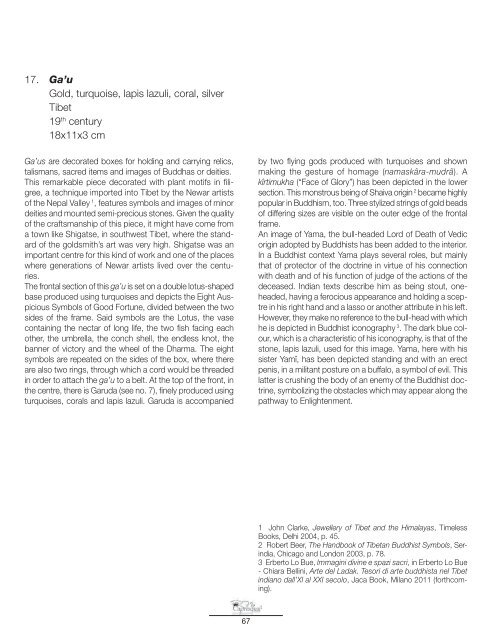Images of Devotion - capriaquar.it
Images of Devotion - capriaquar.it
Images of Devotion - capriaquar.it
Create successful ePaper yourself
Turn your PDF publications into a flip-book with our unique Google optimized e-Paper software.
17. Ga’u<br />
Gold, turquoise, lapis lazuli, coral, silver<br />
Tibet<br />
19 th century<br />
18x11x3 cm<br />
Ga’us are decorated boxes for holding and carrying relics,<br />
talismans, sacred <strong>it</strong>ems and images <strong>of</strong> Buddhas or de<strong>it</strong>ies.<br />
This remarkable piece decorated w<strong>it</strong>h plant motifs in filigree,<br />
a technique imported into Tibet by the Newar artists<br />
<strong>of</strong> the Nepal Valley 1 , features symbols and images <strong>of</strong> minor<br />
de<strong>it</strong>ies and mounted semi-precious stones. Given the qual<strong>it</strong>y<br />
<strong>of</strong> the craftsmanship <strong>of</strong> this piece, <strong>it</strong> might have come from<br />
a town like Shigatse, in southwest Tibet, where the standard<br />
<strong>of</strong> the goldsm<strong>it</strong>h’s art was very high. Shigatse was an<br />
important centre for this kind <strong>of</strong> work and one <strong>of</strong> the places<br />
where generations <strong>of</strong> Newar artists lived over the centuries.<br />
The frontal section <strong>of</strong> this ga’u is set on a double lotus-shaped<br />
base produced using turquoises and depicts the Eight Auspicious<br />
Symbols <strong>of</strong> Good Fortune, divided between the two<br />
sides <strong>of</strong> the frame. Said symbols are the Lotus, the vase<br />
containing the nectar <strong>of</strong> long life, the two fish facing each<br />
other, the umbrella, the conch shell, the endless knot, the<br />
banner <strong>of</strong> victory and the wheel <strong>of</strong> the Dharma. The eight<br />
symbols are repeated on the sides <strong>of</strong> the box, where there<br />
are also two rings, through which a cord would be threaded<br />
in order to attach the ga’u to a belt. At the top <strong>of</strong> the front, in<br />
the centre, there is Garuda (see no. 7), finely produced using<br />
turquoises, corals and lapis lazuli. Garuda is accompanied<br />
67<br />
by two flying gods produced w<strong>it</strong>h turquoises and shown<br />
making the gesture <strong>of</strong> homage (namaskâra-mudrâ). A<br />
kîrtimukha (“Face <strong>of</strong> Glory”) has been depicted in the lower<br />
section. This monstrous being <strong>of</strong> Shaiva origin 2 became highly<br />
popular in Buddhism, too. Three stylized strings <strong>of</strong> gold beads<br />
<strong>of</strong> differing sizes are visible on the outer edge <strong>of</strong> the frontal<br />
frame.<br />
An image <strong>of</strong> Yama, the bull-headed Lord <strong>of</strong> Death <strong>of</strong> Vedic<br />
origin adopted by Buddhists has been added to the interior.<br />
In a Buddhist context Yama plays several roles, but mainly<br />
that <strong>of</strong> protector <strong>of</strong> the doctrine in virtue <strong>of</strong> his connection<br />
w<strong>it</strong>h death and <strong>of</strong> his function <strong>of</strong> judge <strong>of</strong> the actions <strong>of</strong> the<br />
deceased. Indian texts describe him as being stout, oneheaded,<br />
having a ferocious appearance and holding a sceptre<br />
in his right hand and a lasso or another attribute in his left.<br />
However, they make no reference to the bull-head w<strong>it</strong>h which<br />
he is depicted in Buddhist iconography 3 . The dark blue colour,<br />
which is a characteristic <strong>of</strong> his iconography, is that <strong>of</strong> the<br />
stone, lapis lazuli, used for this image. Yama, here w<strong>it</strong>h his<br />
sister Yamî, has been depicted standing and w<strong>it</strong>h an erect<br />
penis, in a mil<strong>it</strong>ant posture on a buffalo, a symbol <strong>of</strong> evil. This<br />
latter is crushing the body <strong>of</strong> an enemy <strong>of</strong> the Buddhist doctrine,<br />
symbolizing the obstacles which may appear along the<br />
pathway to Enlightenment.<br />
1 John Clarke, Jewellery <strong>of</strong> Tibet and the Himalayas, Timeless<br />
Books, Delhi 2004, p. 45.<br />
2 Robert Beer, The Handbook <strong>of</strong> Tibetan Buddhist Symbols, Serindia,<br />
Chicago and London 2003, p. 78.<br />
3 Erberto Lo Bue, Immagini divine e spazi sacri, in Erberto Lo Bue<br />
- Chiara Bellini, Arte del Ladak. Tesori di arte buddhista nel Tibet<br />
indiano dall’XI al XXI secolo, Jaca Book, Milano 2011 (forthcoming).


